FMS FMM126PX Owner's manual
- Category
- Remote controlled toys
- Type
- Owner's manual
This manual is also suitable for

SIMPLE REALISTIC RIGID
FMSMODEL.COM
1400mm Pitts
Manuel d’utilisation
Instruction Manual
Bedienungsanleitung
操作手册


3
WARNING: Read the ENTIRE instruction manual to become familiar with the features of the product before operating.
Failure to operate the product correctly can result in damage to the product,personal property and cause serious injury.
This is a sophisticated hobby product and NOT a toy. It must be operated with caution and common sense and failure to do so
could result in injury or damage to the product or other property. This product is not intended for use by children without direct
adult supervision.
This manual contains instructions for safety operation and maintenance. It is essential to read and follow all the instructions and
warnings in the manual prior to assembly, setup or use, in order to operate and avoid damage or serious injury.
WARNING
As the user of this product, you are solely responsible for operating in a manner that does not endanger yourself and others or
result in damage to the product or the property of others. This model is controlled by a radio signal subject to interference from
many sources outside your control. This interference can cause momentary loss of control so it is advisable to always keep a
safe distance in all directions around your model, as this margin will help avoid collisions or injury.
Age Recommendation: Not for children under 14 years. This is not a toy.
·Never operate your model with low transmitter batteries.
·Always operate your model in an open area away from cars, traffic or people.
·Avoid operating your model in the street where injury or damage can occur.
·Never operate the model in populated areas for any reason.
·Carefully follow the directions and warnings for this and any optional support equipment you use (chargers,rechargeable
battery packs, etc.)
·Keep all chemicals, small parts and anything electrical out of the reach of children.
·Moisture causes damage to electronics. Avoid water exposure to all equipment not specifically designed and protected for this
purpose.
·Never lick or any place of any your model in your mouth as it could cause serious injury or even death.
Lithium Polymer (Li-Po) Battery Warning
CAUTION: Always follow the manufacturer’s instructions for safe use and disposal of batteries. Fire, property
damage, or serious injury can result from the mishandling of Li-Po batteries.
By handling, charging or using a Li-Po Battery you assume all risks associated with lithium batteries.
If at any time the batteries begin to swell or balloon, discontinue use immediately!
Always store the batteries at room temperature in a dry area to extend the life of the battery. Always transport
or temporarily store the battery in a temperature range of 40-120F. Do not store the battery or model in a car or in direct sunlight.
If stored in a hot car, the battery can be damaged or even catch fire.
Never use a Ni-Mh Charger to charge Li-Po Batteries. Failure to charge the battery with a Li-Po compatible charger
may cause fire resulting in personal injury and property damage.
Never discharge Li-Po Cells below 3V.
Never leave charging batteries unattended.
Never charge damaged batteries.
Charging the Flight Battery Warning
Use a battery charger that is designed to safely charge the Li-Po Battery. Read the charger instructions care
fully before use. When charging the battery, make certain the battery is on a heat resistant surface. It is also highly
recommended to place the Li-Po Battery inside a fire resistant charging bag readily available at hobby shops or
online.
p w

4
Before assembly, please inspect the contents of the kit. The
photo below details the contents of the kit with labels. If any
parts are missing or defective, please identify the name or
part number (refer to the spare parts list near the end of the
manual) then contact your local shop or email us: support
Kit contents
Introduction
Kit contents
Model assembly
Battery installation
Receiver diagram
Get your model ready to fly
Clevis installation
Control horn and servo arm settings
Center of gravity(CG)
Before flying the model
Flying course
Troubleshooting
Spare parts list content
Table of contents
····························································· 4
4
······················································· 5
9
9
9
11
11
11
12
12
13
13
····················································
········································
·····················································
·····························································
····················································
····························
··············································
············································
························································
·····················································
············································
Introduction
Wingspan: 1400mm (55.1 in)
Overall Length: 1298mm (51.1 in)
Flying Weight: ~ 3500g
Motor Size: 4258 KV460
Wing Load: 72.5 g/dm² (0.15oz/in²)
Wing Area: 48.3 dm² ( 748.5 sq.in)
ESC: 50A
Servo: 17g Servo x 4
Recommended Battery: 22.2V 4000mAh 35c
Specifications
@fmsmodel.com
The Pitts Special is a light aerobatic biplane designed by Curtis
Pitts. It has accumulated many competitions wins since its first
flight in 1944. The Pitts biplanes dominated world aerobatic
competition in the 1960s and 1970s and, even today, remain a
potent competition aircraft in the lower categories.
Built upon the successful V1 Pitts biplane, FMS is proud to
announce the brand-new Pitts V2. Redesigned with a massive
1400mm wingspan, the Pitts V2 is constructed of lightweight
and robust EPO foam material. Proprietary connector plugs
built into the wing structure means that the wings can be
attached to and detached from the fuselage using just a few
screws. The slide-fit wing struts are just as simple, slide them
on in just a few seconds and the wing is securely braced!
An oversized battery bay accommodates most 6S packs with
ease- giving the pilot ample power to attempt all aerobatic
maneuvers. Hobbywing 50A ESC provides bulletproof perfor-
mance!
While ensuring that the Pitts Special is faithfully recreated,
FMS has worked hard to minimize its profit margins in the
hopes that pilots who love the Pitts V2 will find it affordable.
With graceful lines from a bygone era, robust airframe and a
state-of-the-art power system, the Pitts V2 is a model you
shouldn’t miss!
Features:
Power: 4258 brushless motor, 50A Hobbywing-sourced
ESC, 17g servos
Realistic trim scheme, rivets, panel lines and pilot figure
Screw-together assembly greatly reduces assembly time.
Oversized battery compartment for larger, more powerful
6S packs.
Robust and durable EPO construction.
•
•
•
•
•
A: Fuselage
B:Horizontal stabilizer
C: Vertical stabilizer
D: Landing gear
E: Propeller
components
F:Interplane struts
G:Lower main wings
H:Upper main wings
I :Horizontal
stabilizer struts
K:pushrods and
Screws
( KA2.0X8mm*4
KA2.6X12mm*1
HKM3.0X20mm*4
HKM3.0X10mm*12)
J:Wing spar
A.
C.
D. E. F.
G.
H.
K.
I. J.
B.

5
Model assembly
Main landing gear assembly
Lower wing assembly
2. With the fuselage inverted, install the landing gear
assembly and retainer then secure it with screws as
shown in the diagram.
KA2.0*8mm
HKM3.0*20mm
1. With the fuselage still inverted, install the wing
spar and the wing halves. Secure the wing sections
with the inclulowerde screws.
HKM3.0*10mm
M3 screw nut
1.Apply screw nuts to the plastic parts as shown.

Installation of the horizontal and vertical stabilizers
1. Install the horizontal stabilizer into the fuselage
cutout and secure the assembly with screws.
HKM3.0*10mm
6
Model assembly
2. Align the vertical stabilizer with the horizontal
stabilizer and push the surface down and forward
until it is held securely in place.
3. Secure the vertical stabilizer and tail wheel using
the included screws.
HKM3.0*10mm
KA2.6x12mm
1. Install the pushrod to the control horn on the
vertical stabilizer as shown.
Pushrod installation

2. Install the pushrod to the control horn on the
horizontal stabilizer as shown.
7
Model assembly
1. Connect the horizontal stabilizer and the fuse-
lage using the included horizontal stabilizer struts
by sliding them into place.
Upper wing installation
1. Install the interplane struts onto the retainer on
the lower wing.
Installation of the horizontal stabilizer struts

2. Install the wing spar between the two upper wing
halves.
3. Secure the upper wing onto the mounting bracket by
using the included screws and retainer as shown in the
diagram.
HKM3.0*10mm
8
Model assembly
5. Connect the aileron pushrods between the
upper and lower wings as shown in the diagram.
4. Once both wing halves are aligned, push the inter-
plane strut rearwards to lock the structure.
Propeller installation
1. Assemble the propeller and spinner in the order
shown.
HKM3.0*10mm

Important ESC and model information
The ESC included with the model has a safe start. If the motor battery is connected to the ESC and the throttle stick is not in
the low throttle or off position, the motor will not start until the throttle stick is moved to the low throttle or off position. Once the
throttle stick is moved to the low throttle or off position, the motor will emit a series of beeps. Several beeps with the same tune
means the ESC has detected the cells of the battery. The count of the beeps equals the cells of the battery. The motor is now
armed and will start when the throttle is moved.
The motor and ESC come pre-connected and the motor rotation should be correct. If for any reason the motor is rotating in the
wrong direction, simply reverse two of the three motor wires to change the direction of rotation.
The motor has an optional brake setting. The ESC comes with brake switched off and we recommend that the model be flown
with the brake off. However, the brake could be accidentally switched on if the motor battery is connected to the ESC while the
throttle stick is set at full throttle. To switch the brake off, move the throttle stick to full throttle and plug in the motor battery. The
motor will beep one time. Move the throttle stick to low throttle or the off position. The motor is ready to run and the brake will
be switched off.
Battery Selection and Installation. We recommend the 22.2V 4000mAh 35c Li-Po battery. If using another battery, the battery
must be at least a 22.2V 4000mAh 35c battery. Your battery should be approximately the same capacity, dimension and weight
as the 22.2V 4000mAh 35c Li-Po battery to fit the fuselage without changing the center of gravity significantly.
1.
2.
3.
4.
9
1.Pull back on the latch and remove the battery hatch.
2.Apply the hook tape to the cable end of the battery.
3.Slide the full charged battery into the battery compartment
with the power supply cable toward the rear end of the plane.
Note: The center of gravity can be adjusted by moving the
battery forward or aft.Having the correct center of gravity is
critical to achieving proper flight characteristics.
spare
Battery installation
Receiver diagram
Get your model ready to fly
The cables from the servo connector board should be
connected to your receiver in the order shown. Note that the
LEDs can be powered by any spare channel on the receiver.
Tuck the wire leads into the recessed cavity towards the rear
of the battery hatch.

Transmitter and model setup
Before getting started, bind your receiver with your transmitter.
Please refer to your transmitter manual for proper operation.
CAUTION: To prevent personal injury, DO NOT install the propel-
ler assembly onto the motor shaft while testing the control surfac-
es. DO NOT arm the ESC and do not turn on the transmitter until
the Transmitter Manual instructs you to do so.
Tips: Make sure all control sticks on your radio are in the neutral
position (rudder, elevator, ailerons) and the throttle is in the OFF
position. Make sure both ailerons move up and down (travel) the
same amount. This model tracks well when the left and right
ailerons travel the same amount in response to the control stick.
Move the controls on the transmitter to make sure the aircraft
control surface moves correctly. See diagrams right.
10
Control throws
The suggested control throw setting for the pitts are as follows (dual rate setting):
Tips: On the first flight, fly the model in low rate.
The first time you use high rates,be sure to fly at
low to medium speeds. High rate, as listed, is
only for EXTREME maneuvering.
Aileron
Bank left
Bank right
Elevator
Climb
Descend
Steering Rudder
Steer left
Steer right
20mm up / dowm 16mm up / dowm
14mm up / dowm
20mm left / right
18mm up / dowm
24mm left / right

11
More control throw
Less control throw
Horns Arms
a.
b.
c.
d.
e.
f.
Clevis installation
1.Pull the tube from the clevis to the linkage.
2.Carefully spread the clevis, then insert the clevis pin into the
desired hole in the control horn.
3.Move the tube to hold the clevis on the control horn.
Control horn and servo arm settings
The table shows the factory settings for the control horns
and servo arms. Fly the aircraft at the factory settings
before making changes.
After flying,you may choose to adjust the linkage positions
for the desired control response.
ElevatorRudderAilerons
Check the C.G. (Center of gravity)
When balancing your model, adjust the battery as necessary
so the model is level or slightly nose down. This is the correct
balance point for your model. After the first flight, the CG
position can be adjusted for your personal preference.
1. The recommended Center of Gravity (CG) location for your
model is(155-165mm) from the leading edge of the main wing
(as shown) with the battery pack installed. Mark the location of
the CG on top of the wing.
2. When balancing your model, support the plane at the marks
made on the bottom of the main wing with your fingers or a
commercially available balancing stand. This is the correct
balance point for your model. Make sure the model is assembled
and ready for flight before balancing.
155-165mm

Take off
Maintenance
Landing
Find a suitable flying site
Perform the range check for your plane
Monitor your flight time
Find a flying site clear of buildings, trees, power lines and
other obstructions. Until you know how much area will be
required and have mastered flying your plane in confined
spaces, choose a site which is at least the size of two to three
football fields - a flying field specifically for R/C planes is best.
Never fly near people - especially children, who can wander
unpredictably.
As a precaution, an operational ground range test should be
performed before the first flight each time you go out.
Performing a range test is a good way to detect problems
that could cause loss of control such as low batteries, defective
or damaged radio components, or radio interference. This
usually requires an assistant and should be done at the actual
flying site you will be using.
First turn on the transmitter, then install a fully-charged battery
into the fuselage. Connect the battery and install the hatch.
Remember, use care not to bump the throttle stick. Otherwise,
the propeller/fan will turn and possibly cause damage or injury.
Note: Please refer to your Transmitter Manual that came with
your radio control system to perform a ground range check. If
the controls are not working correctly or if anything seems
wrong, do not fly the model until you correct the problem. Make
certain all the servo wires are securely connected to the
receiver and the transmitter batteries have a good connection.
Monitor and limit your flight time using a timer (such as on a
wristwatch or in your transmitter if available). When the
batteries are getting low you will usually notice a performance
drop before the ESC cuts off motor power, so when the plane
starts flying slower you should land. Often (but not always)
power can be briefly restored after the motor cuts off by
holding the throttle stick all the way down for a few seconds.
To avoid an unexpected dead-stick landing on your first flight,
set your timer to a conservative 4 minutes. When your alarm
sounds you should land right away.
12
Before flying the model
Flying course
While applying power, slowly steer to keep the model straight.
The model should accelerate quickly. As the model gains flight
speed you will want to climb at a steady and even rate. It will
climb out at a nice angle of attack (AOA).
Flying
Always choose a wide-open space for flying your plane. It is
ideal for you to fly at a sanctioned flying field. If you are not
flying at an approved site always avoid flying near houses,
trees, wires and buildings. You should also be careful to avoid
flying in areas where there are many people, such as busy
parks, schoolyards, or soccer fields. Consult laws and
ordinances before choosing a location to fly your aircraft. After
takeoff, gain some altitude. Climb to a safe height before trying
technical manoeuvres, including high speed passes, inverted
flight, loops, and point rolls.
Land the model when you hear the motor pulsing (LVC) or if
you notice a reduction in power. If using a transmitter with a
timer, set the timer so you have enough flight time to make
several landing approaches.
The model’s three point landing gear allows the model to land
on hard surfaces. Align model directly into the wind and fly
down to the ground. Fly the airplane down to the ground using
1/4-1/3 throttle to keep enough energy for proper flare. Before
the model touches down, always fully decrease the throttle to
avoid damaging the propeller or other components. The key to
a great landing is to manage the power and elevator all the
way to the ground and set down lightly on the main landing
gear. After a few flights you will find the model can be set down
lightlyon the mains and you can hold the nose wheel off
balancing themodel on the mains until it slows and gently
settles the nose.
Repairs to the foam should be made with foam safe adhesives
such as hot glue, foam safe CA, and 5min epoxy. When parts
are not repairable, see the Spare Parts List for ordering by item
number.
Always check to make sure all screws on the aircraft are
tightened. Pay special attention to make sure the spinner is
firmly in place before every flight.

13
Trouble shooting
Problem Possible Cause Solution
Aircraft will not respond to
the throttlebut responds to
other controls.
-ESC is not armed.
-Throttle channel is reversed.
-Lower throttle stick and throttle trim to lowest settings.
-Reverse throttle channel on transmitter.
Extra propeller noise or
extra vibration.
-Damaged spinner, propeller,
motor or motor mount.
-Loose propeller and spinner parts.
-Propellor installed backwards.
-Replace damaged parts.
-Tighten parts for propeller adapter, propeller and spinner.
-Remove and install propeller correctly.
Reduced flight time or
aircraft underpowered.
-Flight battery charge is low.
-propeller installed backward.
-Flight battery damaged.
-Completely recharge flight battery.
-Replace flight battery and follow flight battery
instructions.
Control surface does not
move, or is slow to respond
to control inputs.
-Control surface, control horn,
linkage or servo damage.
-Wire damaged or connections
loose.
-Replace or repair damaged parts and adjust controls.
-Do a check of connections for loose wiring.
Controls reversed.
Channels are reversed in the
transmitter.
Do the control direction test and adjust controls for
aircraft and transmitter.
-Motor loses power
-Motor power pulses then
motor loses power.
-Damage to motor, or battery.
-Loss of power to aircraft.
-ESC uses default soft Low Voltage
Cutoff(LVC).
-Do a check of batteries, transmitter, receiver, ESC, motor
and wiring for damage(replace as needed).
-Land aircraft immediately and recharge flight battery.
LED on receiver flashes
slowly.
Power loss to receiver.
-Check connection from ESC to receiver.
-Check servos for damage.
-Check linkages for binding.
Spare parts list content
FMSRY101
FMSRY102
FMSRY103
FMSRY104
FMSRY105
FMSRY106
FMSRY107
FMSRY108
FMSRY109
FMSRY110
FMSRY111
FMSRY112
FMSRY113
FMSRY114
FMSRY115
Fuselage
Main Wing Set(top)
Main Wing Set(lower)
Vertical Stabilizer
Horizontal Stabilizer
Canopy
Canopy
Cowl
Front Landing Gear Set
Front Landing Gear Mounting Plate
Interplane Strut
Cabane
Spinner
Inclined Stay Bar
Rear landing Gear Assembly
FMSRY116
FMSRY117
FMSRY118
FMSRY119
FMSRY120
FMSPROP035
FMSBM003
FMSDZ005
FMSDJ014
PRKV460E
PRESC033
FMS17GAP
Linkage Rod
Screws Set
Stickers
Pipe
Battery Tray
Propeller
Motor Board
Motor Shaft
Motor Mount
4258-KV460 motor
50A ESC with 5A BEC
17g analog gear servo positive
Visit our website: www.fmsmodel.com to see photo of this product. Enter the key word "ESC" in the search bar for the
stock ESC instruction manual.
-
 1
1
-
 2
2
-
 3
3
-
 4
4
-
 5
5
-
 6
6
-
 7
7
-
 8
8
-
 9
9
-
 10
10
-
 11
11
-
 12
12
-
 13
13
FMS FMM126PX Owner's manual
- Category
- Remote controlled toys
- Type
- Owner's manual
- This manual is also suitable for
Ask a question and I''ll find the answer in the document
Finding information in a document is now easier with AI
Related papers
-
FMS Models FMM007RAB Owner's manual
-
FMS 1400mm J-3 V3 User manual
-
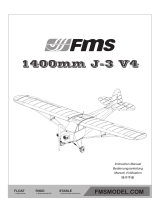 FMS Models FMM106P Owner's manual
FMS Models FMM106P Owner's manual
-
FMS Models FMM071RX Owner's manual
-
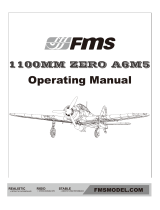 FMS Models FMM082P Owner's manual
FMS Models FMM082P Owner's manual
-
FMS Models FMM124P Owner's manual
-
FMS Sbach 342 Operating instructions
-
FMS FMM080P Owner's manual
-
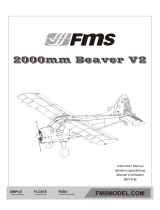 FMS Models FMM090P1 Owner's manual
FMS Models FMM090P1 Owner's manual
-
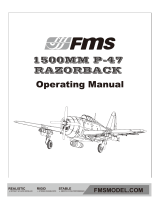 FMS Models FMM089PX Owner's manual
FMS Models FMM089PX Owner's manual
Other documents
-
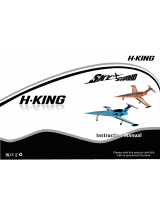 H-KING Sky Sword User manual
H-KING Sky Sword User manual
-
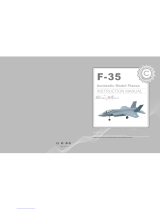 StarMax F-35 User manual
StarMax F-35 User manual
-
Arrows AH015P User manual
-
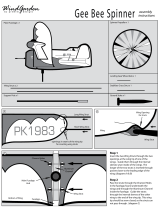 Premier designs Wind Garden Gee Bee Spinner Assembly Instructions
Premier designs Wind Garden Gee Bee Spinner Assembly Instructions
-
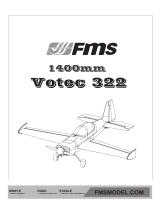 FMS Models FMM1011P Owner's manual
FMS Models FMM1011P Owner's manual
-
E-flite PITTS S-1S Owner's manual
-
E-flite Pitts Model 12 15e ARF Assembly Manual
-
Tower Hobbies Ultimate Bipe GP/EP ARF User manual
-
Black Horse Model Pitts BH85-A User manual
-
E-flite EFL124500 Owner's manual




















